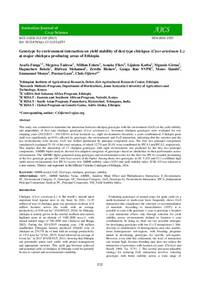Genotype by environment interaction on yield stability of desi type chickpea (Cicer arietinum L.) at major chickpea producing areas of Ethiopia

Authors:
This study was conducted to determine the interaction between chickpea genotypes with the environment (GxE) on the yield stability and adaptability of desi type chickpea genotypes (Cicer arietinum L.). Seventeen chickpea genotypes were evaluated for two cropping years (2012/2013 – 2013/2014) at four locations i.e., eight environments (locations x years combination). Chickpea grain yield was significantly (p<0.01) affected by genotypes, the environments and GxE interaction, indicating that the varieties and the test environments were diverse. GxE was further partitioned by principal component axes. The first two principal components cumulatively explained 53.1% of the total variation, of which 32.7% and 20.4% were contributed by IPCA1 and IPCA2, respectively. This implies that the interaction of 17 chickpea genotypes with eight environments was predicted by the first two principal components. AMMI 1 biplot analysis showed five adaptive categories of genotypes based on similarities in their performance across environments. The AMMI 2 biplot generated using genotypes and environmental scores for the first two IPCAs revealed positioning of the five genotype groups (GC) into four sectors of the biplot. Among them, two genotypes in GC 5 (G5 and G11) exhibited high yields across environments, low IPCA1 scores, low AMMI stability value (ASV) and yield stability index (YSI). G5 was released as a new variety, ‘Dimtu’ and registered in the Official Varieties Catalogue of Ethiopia, 2016.
